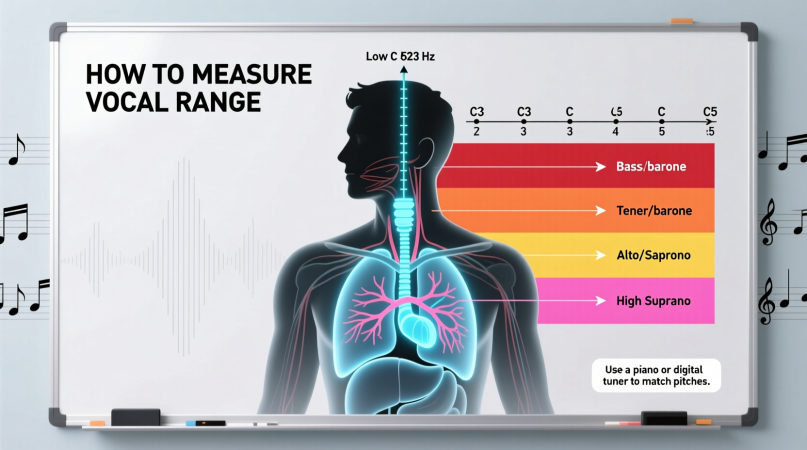
To measure your vocal range, find the lowest and highest notes you can sing comfortably, then calculate the distance between them in octaves. Most singers fall between 1.5 and 2 octaves, while trained vocalists may reach 2.5 to 3 octaves or more.
Why Knowing Your Vocal Range Matters
Measuring your vocal range isn’t about showing off high notes. It helps you:
- Pick songs that actually fit your voice.
- Avoid strain and vocal damage.
- Understand whether you’re closer to a soprano, alto, tenor, baritone, or bass.
- Track your progress as your singing improves.
Step 1: Warm Up Your Voice
Never test your range cold. A few minutes of warm-ups will keep your voice safe:
- Gentle humming
- Lip trills (like blowing air through relaxed lips)
- Light scale runs on “ah” or “oo”
- Sirens (sliding smoothly from low to high)
This prepares your vocal cords and ensures your test is accurate.
Step 2: Find Your Lowest Note
- Sit at a piano, keyboard, or open a digital tuner app.
- Start around your mid-range (middle C is a good anchor).
- Move down step by step.
- Stop when your voice turns unstable or loses tone quality.
- The last clear, comfortable note is your lowest pitch.
Step 3: Find Your Highest Note
- Begin again in mid-range.
- Move up one half-step at a time.
- Notice when your voice feels tight, airy, or forced.
- The last comfortable, stable pitch is your highest note.
Step 4: Calculate Your Vocal Range
Write down both ends of your range. For example:
- Lowest note: A2
- Highest note: C5
That span equals 2 octaves and a minor third.
👉 You can map your results on a piano chart or use an online vocal range calculator to get a visual breakdown.
Step 5: Identify Your Voice Type
Here’s a quick reference chart for typical classical voice categories:
| Voice Type | Usual Range (approx.) |
|---|---|
| Soprano | C4 – C6 |
| Mezzo-Soprano | A3 – A5 |
| Alto/Contralto | F3 – E5 |
| Tenor | B2 – A4 |
| Baritone | G2 – G4 |
| Bass | E2 – E4 |
Remember: these are averages. Your range might overlap categories, and that’s normal.
Manual Testing vs. Apps
You can measure range with:
- Piano/Keyboard – most accurate, note by note.
- Pitch Detector Apps – instantly show lowest/highest notes.
- Online Range Tests – convenient if you don’t play an instrument.
Many singers combine both methods: a piano for accuracy, an app for quick checks.
Range vs Tessitura
Your range is the full set of notes you can hit.
Your tessitura is where your voice feels natural.
Example: you might technically reach 3 octaves, but your tessitura may only cover 1.5 comfortably. That’s where you’ll sound your best in performance.
FAQs
How often should I test my range?
Every few months, since range can expand with training.
Should falsetto count?
Yes, but list it separately from your chest/head voice.
Can vocal range change with age?
Yes, voices may deepen or lose flexibility over time.
Is a 2-octave range good?
Yes. Two octaves is average and enough for most songs.
Do I need a teacher to measure range?
Not necessarily—apps and pianos work fine, but a coach ensures accuracy.
